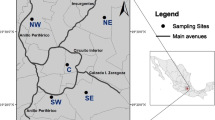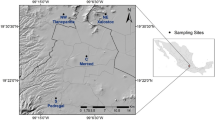Abstract
The Mexico City Metropolitan Area (MCMA) was the object of a chemical elemental characterization (Ti, V, Cr, Mn, Co, Ni, Cu, Mo, Ag, Cd, Sb, Pb, La, Sm, Ce, and Eu) of PM2.5 collected during 2013 and analyzed by inductively coupled plasma mass spectrometry (ICP-MS). Sampling campaigns were carried out at five locations simultaneously—northwest, northeast, center, southwest, and southeast—during dry-warm season (April), rainy season (August), and dry-cold season (November). By means of enrichment factor (EF) and principal component analysis (PCA), it was possible to attribute the analyzed elements to geogenic and anthropogenic sources, as well as to identify a group of elements with mixed provenance sources. The highest concentrations for most metals were found in northwest and northeast, and during dry-warm (DW), confirming the trend observed in PM2.5 samples collected in 2011. Despite similarities between 2011 and 2013, an increase of 17% in PM2.5 mass concentration was observed, mainly attributable to geogenic sources, whereby the importance of wind intensity to the impact of emission sources is highlighted. The effect of wind intensity was revealed, by means of polar plots, as the controlling mechanism for this increase. This allowed us to conclude that high-speed episodes (5 m s−1) were responsible for raising geogenic metal concentrations rather than wind direction.





Similar content being viewed by others
References
Aldabe, J., Elustondo, D., Santamaría, C., Lasheras, E., Pandolfi, M., Alastuey, A., Querol, X., & Santamaría, J. M. (2011). Chemical characterisation and source apportionment of PM2. 5 and PM10 at rural, urban and traffic sites in Navarra (north of Spain). Atmospheric Research, 102(1), 191–205.
Alleman, L. Y., Lamaison, L., Perdrix, E., Robache, A., & Galloo, J. C. (2010). PM 10 metal concentrations and source identification using positive matrix factorization and wind sectoring in a French industrial zone. Atmospheric Research, 96(4), 612–625.
Amador-Muñoz, O., Villalobos-Pietrini, R., Miranda, J., & Vera-Avila, L. E. (2011). Organic compounds of PM 2.5 in Mexico Valley: spatial and temporal patterns, behavior and sources. Science of the Total Environment, 409(8), 1453–1465.
Amador-Muñoz, O., Bazán-Torija, S., Villa-Ferreira, S. A., Villalobos-Pietrini, R., Bravo-Cabrera, J. L., Munive-Colín, Z., Hernández-Mena, L., Saldarriaga-Noreña, H., & Murillo-Tovar, M. A. (2013). Opposing seasonal trends for polycyclic aromatic hydrocarbons and PM10, health risk and sources in Southwest Mexico City. Atmospheric Research., 122, 199–212.
Barrera, V. A., Miranda, J., Espinosa, A. A., Meinguer, J., Martínez, J. N., Cerón, E., et al. (2012). Contribution of soil, sulfate, and biomass burning sources to the elemental composition of PM10 from Mexico city. International Journal of Environmental Research, 6(3), 597–612.
Cheng, Y., Lee, S. C., Ho, K. F., Chow, J. C., Watson, J. G., Louie, P. K. K., Cao, J. J., & Hai, X. (2010). Chemically-speciated on-road PM2. 5 motor vehicle emission factors in Hong Kong. Science of the Total Environment, 408(7), 1621–1627.
DeCarlo, P. F., Dunlea, E. J., Kimmel, J. R., Aiken, A. C., Sueper, D., Crounse, J., Wennberg, P. O., Emmons, L., Shinozuka, Y., Clarke, A., Zhou, J., Tomlinson, J., Collins, D. R., Knapp, D., Weinheimer, A. J., Montzka, D. D., Campos, T., & Jimenez, J. L. (2008). Fast airborne aerosol size and chemistry measurements above Mexico City and Central Mexico during the MILAGRO campaign. Atmospheric Chemistry and Physics, 8(14), 4027–4048.
De Foy, B., Caetano, E., Magana, V., Zitácuaro, A., Cárdenas, B., Retama, A., et al. (2005). Mexico City basin wind circulation during the MCMA-2003 field campaign. Atmospheric Chemistry and Physics Discussions, 5(3), 2503–2558.
Dongarrà, G., Manno, E., Varrica, D., Lombardo, M., & Vultaggio, M. (2010). Study on ambient concentrations of PM 10, PM 10–2.5, PM 2.5 and gaseous pollutants. Trace elements and chemical speciation of atmospheric particulates. Atmospheric Environment, 44(39), 5244–5257.
Hays, M. D., Cho, S. H., Baldauf, R., Schauer, J. J., & Shafer, M. (2011). Particle size distributions of metal and non-metal elements in an urban near-highway environment. Atmospheric Environment, 45(4), 925–934.
Hernández-López, A. E., Miranda, J., & Pineda, J. C. (2016). X-ray fluorescence analysis of fine atmospheric aerosols from a site in Mexico City. Journal of Nuclear. Physics, Material Sciences, Radiation and Applications., 4(1), 25–30.
Johnson, K. S., Foy, B. D., Zuberi, B., Molina, L. T., Molina, M. J., Xie, Y., et al. (2006). Aerosol composition and source apportionment in the Mexico City Metropolitan Area with PIXE/PESA/STIM and multivariate analysis. Atmospheric Chemistry and Physics, 6(12), 4591–4600.
Kampa, M., & Castanas, E. (2008). Human health effects of air pollution. Environmental Pollution, 151(2), 362–367.
Kulshrestha, A., Satsangi, P. G., Masih, J., & Taneja, A. (2009). Metal concentration of PM2. 5 and PM10 particles and seasonal variations in urban and rural environment of Agra, India. Science of the Total Environment, 407(24), 6196–6204.
Ledoux, F., Kfoury, A., Delmaire, G., Roussel, G., El Zein, A., & Courcot, D. (2017). Contributions of local and regional anthropogenic sources of metals in PM2.5 at an urban site in northern France. Chemosphere, 181, 713–724.
Michael, S., Montag, M., & Dott, W. (2013). Pro-inflammatory effects and oxidative stress in lung macrophages and epithelial cells induced by ambient particulate matter. Environmental Pollution, 183, 19–29.
Miranda, J., Barrera, V. A., Espinosa, A. A., Galindo, O. S., & Meinguer, J. (2005). PIXE analysis of atmospheric aerosols in Mexico City. X-Ray Spectrometry, 34(4), 315–319.
Molina, L. T., Madronich, S., Gaffney, J. S., Apel, E., de Foy, B., Fast, J., Ferrare, R., Herndon, S., Jimenez, J. L., Lamb, B., Osornio-Vargas, A. R., Russell, P., Schauer, J. J., Stevens, P. S., Volkamer, R., & Zavala, M. (2010). An overview of the MILAGRO 2006 campaign: Mexico City emissions and their transport and transformation. Atmospheric Chemistry and Physics, 10, 8697–8760.
Moreno, T., Querol, X., Alastuey, A., Reche, C., Cusack, M., Amato, F., Pandolfi, M., Pey, J., Richard, A., Prévôt, A. S. H., Furger, M., & Gibbons, W. (2011). Variations in time and space of trace metal aerosol concentrations in urban areas and their surroundings. Atmospheric Chemistry and Physics, 11(17), 9415–9430.
Morton-Bermea, O., Hernández-Álvarez, E., González-Hernández, G., Romero, F., Lozano, R., & Beramendi-Orosco, L. E. (2009). Assessment of heavy metal pollution in urban topsoils from the metropolitan area of Mexico City. Journal of Geochemical Exploration, 101(3), 218–224.
Morton-Bermea, O., Amador-Muñoz, O., Martínez-Trejo, L., Hernández-Alvarez, E., Beramendi-Orosco, L., & García-Arreola, M. E. (2014). Platinum in PM2.5 of the metropolitan area of Mexico City. Environmental Geochemical Health, 36, 987–994.
Morton-Bermea, O., Garza-Galindo, R., Hernández-Álvarez, E., Amador-Muñoz, O., Garcia-Arreola, M. E., Ordoñez-Godínez, S. L., Beramendi-Orosco, L., Santos-Medina, G. L., Miranda, J., & Rosas-Pérez, I. (2018). Recognition of the importance of geogenic sources in the content of metals in PM 2.5 collected in the Mexico City Metropolitan Area. Environmental Monitoring and Assessment, 190(2), 83.
Mugica, V., Ortiz, E., Molina, L., De Vizcaya-Ruiz, A., Nebot, A., Quintana, R., et al. (2009). PM composition and source reconciliation in Mexico City. Atmospheric Environment, 43(32), 5068–5074.
Pandolfi, M., Gonzalez-Castanedo, Y., Alastuey, A., Jesus, D., Mantilla, E., de la Campa, A. S., et al. (2011). Source apportionment of PM 10 and PM 2.5 at multiple sites in the strait of Gibraltar by PMF: impact of shipping emissions. Environmental Science and Pollution Research, 18(2), 260–269.
Perrone, M. G., Gualtieri, M., Consonni, V., Ferrero, L., Sangiorgi, G., Longhin, E., Ballabio, D., Bolzacchini, E., & Camatini, M. (2013). Particle size, chemical composition, seasons of the year and urban, rural or remote site origins as determinants of biological effects of particulate matter on pulmonary cells. Environmental Pollution, 176, 215–227.
Querol, X., Pey, J., Minguillón, M. C., Pérez, N., Alastuey, A., Viana, M., Moreno, T., Bernabé, R. M., Blanco, S., Cárdenas, B., Vega, E., Sosa, G., Escalona, S., Ruiz, H., & Artíñano, B. (2008). PM speciation and sources in Mexico during the MILAGRO-2006 campaign. Atmospheric Chemistry and Physics, 8(1), 111–128.
Saliba, N. A., El Jam, F., El Tayar, G., Obeid, W., & Roumie, M. (2010). Origin and variability of particulate matter (PM10 and PM2. 5) mass concentrations over an Eastern Mediterranean city. Atmospheric Research, 97(1–2), 106–114.
Santibáñez-Andrade, M., Quezada-Maldonado, E. M., Osornio-Vargas, Á., Sánchez-Pérez, Y., & García-Cuellar, C. M. (2017). Air pollution and genomic instability: the role of particulate matter in lung carcinogenesis. Environmental Pollution, 229, 412–422.
Stone, E. A., Snyder, D. C., Sheesley, R. J., Sullivan, A. P., Weber, R. J., & Schauer, J. J. (2008). Source apportionment of fine organic aerosol in Mexico City during the MILAGRO experiment 2006. Atmospheric Chemistry and Physics, 8(5), 1249–1259.
Uria-Tellaetxe, I., & Carslaw, D. C. (2014). Conditional bivariate probability function for source identification. Environmental Modelling & Software, 59, 1–9.
Wang, Q., Kobayashi, K., Lu, S., Nakajima, D., Wang, W., Zhang, W., Sekiguchi, K., & Terasaki, M. (2016). Studies on size distribution and health risk of 37 species of polycyclic aromatic hydrocarbons associated with fine particulate matter collected in the atmosphere of a suburban area of Shanghai city, China. Environmental Pollution, 214, 149–160.
Warneck, P., & Williams, J. (2012). The atmospheric Chemist’s companion: numerical data for use in the atmospheric sciences. Springer Science & Business Media.
Wedepohl, K. H. (1995). The composition of the continental crust. Geochimica et Cosmochimica Acta, 59(7), 1217–1232.
World Health Organization. (2016). Ambient air pollution: A global assessment of exposure and burden of disease
Yuan, Z., Lau, A. K. H., Zhang, H., Yu, J. Z., Louie, P. K., & Fung, J. C. (2006). Identification and spatiotemporal variations of dominant PM 10 sources over Hong Kong. Atmospheric Environment, 40(10), 1803–1815.
Zhang, C., Ni, Z., & Ni, L. (2015). Multifractal detrended cross-correlation analysis between PM2. 5 and meteorological factors. Physica A: Statistical Mechanics and its Applications, 438, 114–123.
Zhai, Y., Liu, X., Chen, H., Xu, B., Zhu, L., Li, C., & Zeng, G. (2014). Source identification and potential ecological risk assessment of heavy metals in PM2. 5 from Changsha. Science of the Total Environment, 493, 109–115.
Funding
This study was performed with the financial support of Project IN103717 from DGAPA (Dirección General de Personal Académico, UNAM). Rodrigo Garza-Galindo gratefully acknowledges a grant from CONACyT (Consejo Nacional de Ciencia y Tecnología).
Author information
Authors and Affiliations
Corresponding author
Additional information
Publisher’s note
Springer Nature remains neutral with regard to jurisdictional claims in published maps and institutional affiliations.
Rights and permissions
About this article
Cite this article
Garza-Galindo, R., Morton-Bermea, O., Hernández-Álvarez, E. et al. Spatial and temporal distribution of metals in PM2.5 during 2013: assessment of wind patterns to the impacts of geogenic and anthropogenic sources. Environ Monit Assess 191, 165 (2019). https://doi.org/10.1007/s10661-019-7251-4
Received:
Accepted:
Published:
DOI: https://doi.org/10.1007/s10661-019-7251-4




